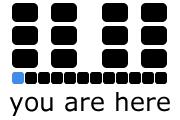Cultural Formation
by Jentery, Curtis, Matthew & Jamie
In many foundational theoretical debates, the term, “cultural formation” can be located at the center of disagreements regarding the precise relation of the cultural domain to economic, political, and social processes, the nature of power as it is articulated and promulgated in and through media of all types, and the particular configuration of identities, genres, histories, and other categories that organize experience and define social order in any given moment. While our group investigation has not addressed these theoretical problematics explicitly, we have chosen the term to coordinate our group’s perspectives on the relationships between metadata, folksonomies, Web composition, and contemporary knowledge/power formations. Curtis frames the general direction of this investigation by resisting the idea of “descriptive” metadata.
What does metadata “describe” and how do we understand the “affordances and constraints” of the work of description? To answer these questions effectively, we must inquire equally into the semantic history which informs various “descriptive” regimes and the ways in which those (multiple) traditions are negotiated or destabilized in actual descriptive practice to do all sorts of cultural work in the here and now.
Here, Curtis outlines the two overlapping lines of inquiry which engage the relation of new media and social formation explicitly, one which attempts to understand how “readymade” cultural categories constrain, inform, and generate metadata, and one which frames tagging and new media composition as social practices with their own resistant or world-making potential. These interests have developed, variously, across a number of key terms and lines of inquiry, including the question of dominant discursive regimes, the framing of categorization and archiving as social practices, and the question of context and rhetorical situation.
Jamie’s insistence that we think of folksonomies like the Commons as “a new social discourse space where arguments are mobilized through metadata itself” opens up the possibility of investigating tagging as a culturally embedded practice which can and should be “read critically.” Of course, in performing this critical reading in our own evaluations of the Flickr Commons, we have also noted that many of the logics that inform metadata are anything but “new;” they often mobilize familiar and utterly predictable rhetorics (about racial identity, for instance) which are not simply the property of the digital domain. For Jentery, the concept of “implicit metadata” (taken from Cory Doctorow’s work) is useful for asking questions of the digital object’s “culturally embedded” nature and for inquiring into “what implicit and explicit standards are fostering the co-production of metadata in the first place.” From this perspective, the method that we have been calling “Standards in the Making” (SITM) often begins by interrogating the unspoken contexts and constraints on the production of metadata in social contexts. Here SITM is a critical lens and a research agenda. Jentery puts it best:
“It is through the explanation of how, by whom, for whom, and to what effects the image is 'merely described' where knowledge production and research occur. Such an explanation might be called a standard in the making.”
But of course, SITM should not be simply understood simply as a diagnostic—it is simultaneously a process and a practice. In this sense, analyses of the politics of metadata as a “social discourse” also work to define a context for resistant representational practices, where normative definitions and interested epistemologies can be identified, specifically addressed, and challenged in the very contexts where they are reproduced. On this track, we might turn to Matt’s suggestion that SITM ultimately calls on us to understand information as “never truly packagable… necessarily mapped… and therefore contingent.” Amongst other things, this aspect of SITM suggests that while cultural formations certainly inform, delimit, and exert significant force within digital compositions and organizational principles (or even that digital representation itself is a significant part of that formation), these structures of knowing never really determine social practices in any totalizing way. It is from this perspective that Curtis proposes that the subsequent question for SITM is, “how we might appropriate [standards] ourselves to construct different narratives.” This perspective argues that composing metadata (as an “argument” and social practice in and of itself) can “cut across” the discrete categories and principles of the dominant cultural formation to construct archives and narratives “against the grain” of received standards. His analysis of racial formation in the “Negro Boy” example, for instance, pinpoints the contradictions and limitations of categories that define racial history, while simultaneously creating a context for new standards that might address those limits. In this sense, our understanding of SITM seeks to dissolve the artificial divide between criticism and practice, by writing through the opportunities that are afforded by metadata’s status as an embedded cultural practice.
